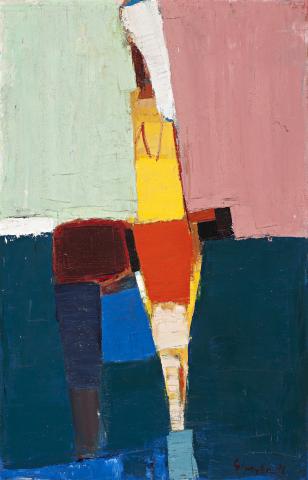FIGURE, 1974
GUY GREY-SMITH
oil and beeswax emulsion on gauze on composition board
121.0 x 77.5 cm
signed lower right: G GREY SMITH
signed, dated and inscribed verso: GUY GREY-SMITH FIGURE 1974
inscribed verso: on label: No 12 / ...
The artist, Perth
Thence by descent
Private collection, Western Australia
Probably Guy Grey-Smith, Rudy Komon Gallery, Sydney, 14 September – 9 October 1974, cat. 11
Guy Grey-Smith was one of the most influential Western Australian artists in the second half of the 20th century. Trained in post-war London by British modernists of the calibre of Henry Moore and Ceri Richards, he maintained a deep adherence to the methodical vision of Cézanne coupled with the rich colouration of Delacroix. Always seeking to strip the motif to bare essentials – to a ‘life force’ – he became particularly drawn to the reductive technique of the Russian artist Nicolas de Staël whose slab-form paintings negotiated the tightrope between figuration and abstraction. In this, Grey-Smith never saw himself as an acolyte, rather he recognised that de Staël ‘is structurally interesting to a painter and basically we are structural engineers if you like – in paint, and this is what interests us about earlier painters … we look to see how paint has been constructed by those before us.’1
Figure drawing had been central to Grey-Smith’s practice from his earliest days in German prisoner-of-war camps where he began sketching to take his mind off the numbing boredom of prison life. It was here, upon seeing a reproduction of a Henry Moore sculpture in Eric Newton’s European Paintings and Sculpture (Penguin, 1941), that the imprisoned pilot experienced an epiphany. Newton had juxtaposed Moore’s figure against a similarly posed sculpture by Michelangelo leading Grey-Smith to recognise that art could be a highly personal response to the world, ‘that it was possible for every individual to say something of his own account.’2 Subsequent travels to Asia in the 1960s – Ceylon (Sri Lanka) in 1962–63, Bali 1968 and Cambodia 1969-70 – exposed him to alternate traditions of sculpture, particularly in temple statues which idealised form whilst maintaining an innate sense of the physicality of the figure.
It is fair to say that whilst that Grey-Smith’s painterly technique was difficult to apply to direct portraiture (with rare exceptions such as the brooding Self Portrait 1966 (Bankwest Art Collection) and the remarkable Son of Mars c.1962, lot XXX in this current auction), it was perfect for capturing the essence of a three-dimensional figure occupying space within its surrounding environment. Standing with one leg raised on a low platform, the subject of Figure, 1974 bends slightly forward and Grey-Smith augments this angle by segmenting the background into four distinct passages of colour applied with painters’ trowels. Bulked up by the artist’s own beeswax emulsion formula, the paint reveals the very edges of his passage with ridges forming at the outer limits of each powerful stroke. The brush features solely to articulate the breast and therefore the female ‘identity’ of the model. In all else, she remains a cypher for a human presence seemingly at rest whilst maintaining a latent energy. The heightened colour also plays its part, a combination of acid pinks and rich blue-greens offset by burnt orange, red and yellow, reminiscent of the West Australian landscape so beloved by the artist.
ANDREW GAYNOR, author of Guy Grey-Smith: life force, University of Western Australia Publishing, 2012.
1. Grey-Smith, quoted in: Hutchings, P., ‘Guy Grey-Smith: Constructivist Painter’, Westerly, Perth, December 1963, p. 85
2. Grey-Smith, quoted in: Thomas, L., ‘In search of a whole wall to plaster’, The Australian, Canberra, 8 March 1969, p. 18
